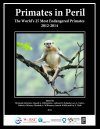Report
By: Christoph Schwitzer(Editor), Russell A Mittermeier(Editor), Anthony B Rylands(Editor), Lucy A Taylor(Editor), Federica Chiozza(Editor), Elizabeth A Williamson(Editor), Janette Wallis(Editor), Fay E Clark(Editor), Stephen D Nash(Illustrator)
87 pages, colour photos, colour illustrations, colour distribution maps, tables
![Primates in Peril: The World's 25 Most Endangered Primates 2012-2014 Primates in Peril: The World's 25 Most Endangered Primates 2012-2014]()
Click to have a closer look
About this book
Customer reviews
Related titles
About this book
This report was released at the International Primatological Society (IPS) meeting in August 2014, Hanoi, Vietnam.
Here the IUCN reports on the seventh iteration of the biennial listing of a consensus of the 25 primate species considered to be among the most endangered worldwide and the most in need of conservation measures.
The 2012–2014 list of the world’s 25 most endangered primates has five species from Africa, six from Madagascar, nine from Asia, and five from the Neotropics. Madagascar tops the list with six species. Vietnam has five, Indonesia three, Brazil two, and China, Colombia, Côte d’Ivoire, the Democratic Republic of Congo, Ecuador, Equatorial Guinea, Ghana, Kenya, Peru, Sri Lanka, Tanzania, and Venezuela each have one.
The changes made in this list compared to the previous iteration (2010–2012) were not because the situation of the nine species that were dropped has improved. In some cases, for example, Varecia variegata, the situation has in fact worsened. By making these changes the editors intend rather to highlight other, closely-related species enduring equally bleak prospects for their survival. An exception may be the greater bamboo lemur, Prolemur simus, for which recent studies have confirmed a considerably larger distribution range and larger estimated population size than previously assumed. However, severe threats to this species in eastern Madagascar remain.
Nine of the primates were not on the previous (2010–2012) list. Seven of them are listed as among the world’s most endangered primates for the first time. The Tana River red colobus and the Ecuadorian brown-headed spider monkey had already been included in previous iterations, but were subsequently removed in favour of other highly threatened species of the same genera. The 2012–2014 list now contains two members each of these genera, thus particularly highlighting the severe threats they are facing.
During the discussion of the 2012–2014 list at the XXIV Congress of IPS in Cancún in 2012, a number of other highly threatened primate species were considered for inclusion. For all of these, the situation in the wild is as precarious as it is for those that eventually made it on the list.
Customer Reviews
Report
By: Christoph Schwitzer(Editor), Russell A Mittermeier(Editor), Anthony B Rylands(Editor), Lucy A Taylor(Editor), Federica Chiozza(Editor), Elizabeth A Williamson(Editor), Janette Wallis(Editor), Fay E Clark(Editor), Stephen D Nash(Illustrator)
87 pages, colour photos, colour illustrations, colour distribution maps, tables



































